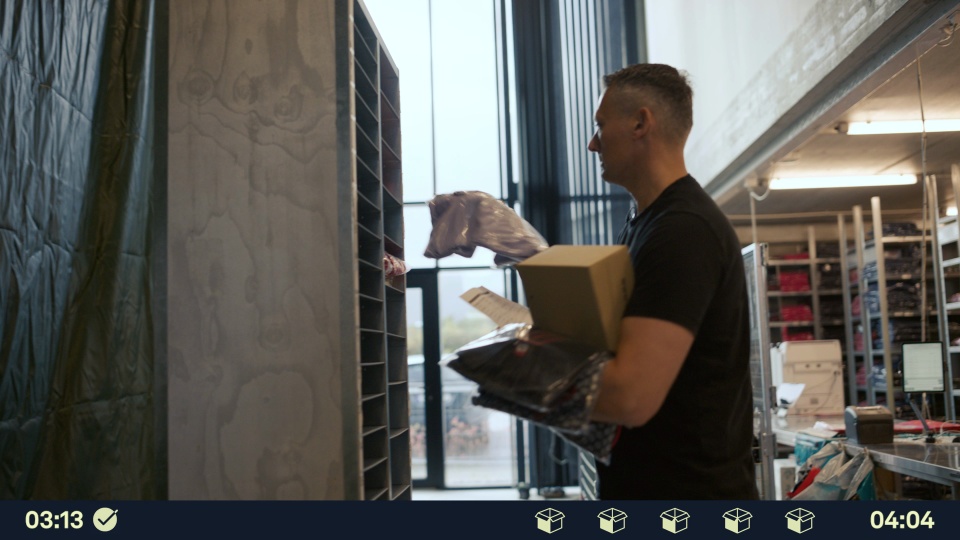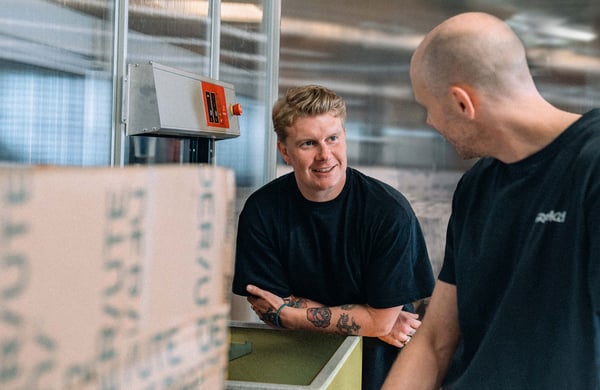This isn’t just about replacing people with machines. It’s about how warehouse automation gives you time back, improves flow, and turns your warehouse into a calm, controlled, and efficient operation.
Picking
Manual Warehouse
In a traditional setup, every order means a new journey through the aisles. Even with a warehouse management system or batch-picking strategies, most of the day is spent walking. That’s thousands of miles a year spent moving instead of fulfilling.
Each pick requires a worker to find, identify, and cross-check products before sending them off to packing. During busy seasons, that time adds up fast. The result? Slower fulfillment, more errors, and exhausted teams.
Automated Warehouse with Pio
Pio warehouse automation flips that process completely. Instead of people chasing products, robots bring the products to people. The system organizes and sequences every order automatically, so picking is faster and easier from the start.
Open the Pio App, choose Pick, and the robots get to work. In moments, a bin arrives at your workstation with the exact products you need. The app guides you step by step, showing which compartment to pick from, since each bin can be divided into different sections depending on how your goods are stored.
If an order needs to go out first, you simply change the priority in the app. Everything moves in sync, keeping your flow steady and your orders on time.
Inbound and Replenishment
Inbound and replenishment are the foundation of a healthy warehouse. When goods arrive, they need to be counted, stored, and organized so they’re ready when orders come in.
Manual Warehouse
In a manual setup, workers receive goods, cross-check them with purchase orders, and walk through aisles to find space on shelves. Replenishment often means pulling products from backstock and moving them around the warehouse again. Decisions about where things go depend on human judgment and memory.
It’s slow, inconsistent, and prone to mistakes that ripple through the rest of your operations.
Automated Warehouse with Pio
With Pio, those same tasks happen in a fraction of the time. Workers tap the Store button in the Pio App, confirm the product, and place it in a bin. The system then decides where to store it in the grid based on demand and available space.
Popular items stay near the top for faster access, while slower movers are stored deeper in the grid. There’s no need for separate backstock or endless walking between shelves. Everything is tracked, stored, and optimized automatically, so your inventory stays accurate and your flow never breaks.
Searching
Sometimes you need to find a product that isn’t part of an active order. Maybe it’s for a photoshoot, a quality check, or a quick inventory count.
Manual Warehouse
In a manual warehouse, that search often starts with a guess. Workers look up the item’s location in the warehouse management system, then walk to find it. If something was misplaced or not logged correctly, it can turn into a slow, frustrating hunt through the aisles.
Every extra step increases the chance of errors, especially if someone forgets to update the system after moving a product. Small inaccuracies in inventory can grow into big problems over time.
Automated Warehouse with Pio
With Pio, searching becomes fast and precise. Workers open the Pio App, type in the product name or SKU, and see exactly where it’s stored down to which bin it is in. They can request that bin to be brought straight to the workstation, or even queue multiple bins if the product appears in more than one place.
When the bin arrives, it’s easy to inspect or count the item, then send it back into the grid. Every action is automatically logged, including who accessed the item and when, giving you full traceability across your entire inventory.
It’s search without the walking, and control without the guesswork.
Returns
Returns are an unavoidable part of running ecommerce or 3PL logistics. They take time, space, and focus, and if the process isn’t efficient, they can quietly drain productivity.
Manual Warehouse
In a traditional setup, workers inspect the returned item, record the reason for return, and update the ecommerce or warehouse management system. If the item passes inspection, it’s manually placed back on the shelf where it was first picked.
That sounds simple, but accuracy depends entirely on the person doing it. If the product ends up in the wrong location or the system isn’t updated correctly, your inventory data starts slipping out of sync, and small errors multiply over time.
Automated Warehouse with Pio
With Pio, the process is faster, cleaner, and much more accurate. After the item is inspected, the worker registers the return in the system. From there, the robots take over as they bring a bin with available space to the workstation. The worker places the item inside, confirms it in the app, and the bin is sent back into the grid.
At the same time, the system updates the product location and inventory count in real time. There’s no need to find its original shelf or double-check numbers manually. Pio keeps everything synced automatically.
That level of precision comes from cube storage automation, the same technology that powers every Pio system. It keeps your returns flowing smoothly and your inventory data perfectly aligned.
Cube Storage
At the heart of every Pio system is cube storage automation. Instead of long aisles and tall shelving, products are stored in compact bins stacked neatly inside a cube-shaped grid. Robots move across the top of the grid, retrieving exactly what’s needed when it’s needed.
This design makes the most of your warehouse space while keeping every process fast and consistent.
You get more capacity in the same footprint, faster fulfillment, and fewer human errors along the way.
For small and growing warehouses, cube storage delivers the power of large-scale automation in a setup that’s simple to install, easy to run, and built to scale with your business.
Cube Storage for Small Businesses explores how this technology makes warehouse automation accessible, efficient, and ready for growth.
KO:KO’s Story
We ran a speed test with KO:KO, a Norwegian apparel brand that thought their warehouse was already efficient. Then they installed Pio.
Using real footage from their warehouse, we compared KO:KO’s manual fulfillment process to an automated one with Pio. The setup was identical: same orders, same products, same start and finish points.
The results spoke for themselves:
- Manual fulfillment took 8 minutes and 9 seconds
- Automated with Pio took 3 minutes and 13 seconds
- Pio’s process was more than twice as fast, with smoother flow and far less effort from the team
Today, KO:KO ships customer orders in less than half the time. Their team works with less pressure, and every process runs with precision. Watch the speed test below:

Ready to Rethink Your Warehouse?
Warehouse automation isn’t just about robots. It’s about creating a smarter, calmer, and more predictable way to work.
With Pio, automation becomes accessible for small and growing businesses. It installs quickly, connects easily to your existing systems, and scales effortlessly as you grow.
From receiving to picking, searching, and returns, every process becomes faster, clearer, and more reliable. Your team spends less time chasing boxes and more time focusing on what really drives the business forward.
Automation isn’t the future anymore. It’s here, and it’s ready when you are.


%20(1).png?width=1920&name=Manual%20Warehouse%20(1442%20x%201080%20px)%20(1).png)


.jpg?width=600&name=Beauty-Welness-Pio-04743%20(1).jpg)